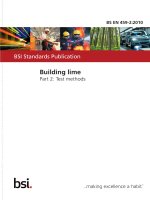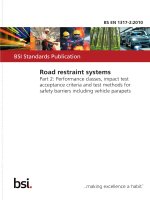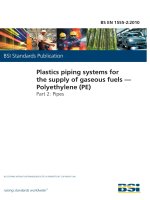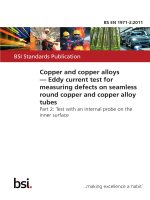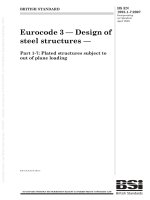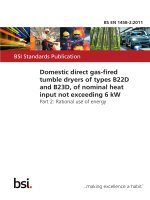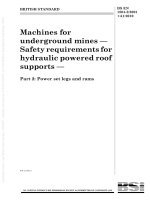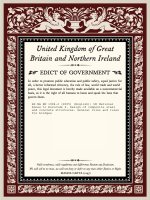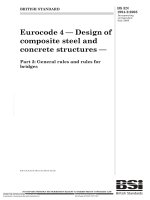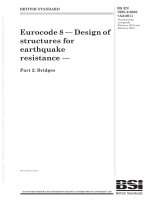Bsi bs en 60730 2 7 2010 (2011)
Bạn đang xem bản rút gọn của tài liệu. Xem và tải ngay bản đầy đủ của tài liệu tại đây (1.53 MB, 24 trang )
BS EN 60730-2-7:2010
Incorporating corrigendum December 2011
BSI Standards Publication
Automatic electrical controls
for household and similar use
Part 2-7: Particular requirements for timers
and time switches
BRITISH STANDARD
BS EN 60730-2-7:2010
National foreword
This British Standard is the UK implementation of EN 60730-2-7:2010,
incorprating corrigendum December 2011. It was derived from
IEC 60730-2-7:2008. It supersedes BS EN 60730-2-7:1992, which will be
withdrawn on 1 October 2013.
The start and finish of text introduced or altered by corrigendum
is indicated in the text by tags. Text altered by CENELEC
corrigendum December 2011 is indicated in the textˆ‰
by
.
The CENELEC common modifications have been implemented at the
appropriate places in the text and are indicated by tags (e.g. }~).
The UK participation in its preparation was entrusted to Technical Committee
CPL/72, Electrical control devices for household equipment and appliances.
A list of organizations represented on this committee can be obtained on
request to its secretary.
This publication does not purport to include all the necessary provisions of a
contract. Users are responsible for its correct application.
© The British Standards Institution 2012
ISBN 978 0 580 77552 9
ICS 39.040.99; 97.120
Compliance with a British Standard cannot confer immunity
from legal obligations.
This British Standard was published under the authority of the
Standards Policy and Strategy Committee on 30 April 2011.
Amendments/corrigenda issued since publication
Date
Text affected
29 February 2012
Implementation of CENELEC corrigendum
December 2011
EUROPEAN STANDARD
EN 60730-2-7
NORME EUROPÉENNE
October 2010
EUROPÄISCHE NORM
ICS 97.120
Incorporating corrigendum December 2011
Supersedes EN 60730-2-7:1991 + corr. Mar.2001 + A1:1997 + corr. Mar.2001 + A11:1994 +
corr. Mar.2001 + A12:1993 + corr. Mar.2001 + A13:2003 + A14:2003
English version
Automatic electrical controls for household and similar use Part 2-7: Particular requirements for timers and time switches
(IEC 60730-2-7:2008, modified)
Dispositifs de commande électrique
automatiques à usage domestique et
analogue Partie 2-7: Règles particulières pour les
minuteries et les minuteries cycliques
(CEI 60730-2-7:2008, modifiée)
Automatische elektrische Regel- und
Steuergeräte für den Hausgebrauch und
ähnliche Anwendungen Teil 2-7: Besondere Anforderungen an
Zeitsteuergeräte und Schaltuhren
(IEC 60730-2-7:2008, modifiziert)
This European Standard was approved by CENELEC on 2010-10-01. CENELEC members are bound to comply
with the CEN/CENELEC Internal Regulations which stipulate the conditions for giving this European Standard
the status of a national standard without any alteration.
Up-to-date lists and bibliographical references concerning such national standards may be obtained on
application to the Central Secretariat or to any CENELEC member.
This European Standard exists in three official versions (English, French, German). A version in any other
language made by translation under the responsibility of a CENELEC member into its own language and notified
to the Central Secretariat has the same status as the official versions.
CENELEC members are the national electrotechnical committees of Austria, Belgium, Bulgaria, Croatia, Cyprus,
the Czech Republic, Denmark, Estonia, Finland, France, Germany, Greece, Hungary, Iceland, Ireland, Italy,
Latvia, Lithuania, Luxembourg, Malta, the Netherlands, Norway, Poland, Portugal, Romania, Slovakia, Slovenia,
Spain, Sweden, Switzerland and the United Kingdom.
CENELEC
European Committee for Electrotechnical Standardization
Comité Européen de Normalisation Electrotechnique
Europäisches Komitee für Elektrotechnische Normung
Management Centre: Avenue Marnix 17, B - 1000 Brussels
© 2010 CENELEC -
All rights of exploitation in any form and by any means reserved worldwide for CENELEC members.
Ref. No. EN 60730-2-7:2010 E
BS EN 60730-2-7:2010
EN 60730-2-7:2010 (E)
–2–
Foreword
The text of the International Standard IEC 60730-2-7:2008, prepared by IEC TC 72, Automatic
controls for household use, together with the common modifications prepared by the Technical
Committee CENELEC TC 72, Automatic controls for household use, was submitted to the CENELEC
Unique Acceptance Procedure and was approved as ˆEN 60730-2-7‰on 2010-10-01.
This document supersedes EN 60730-2-7:1991 + A1:1997 + A11:1994 + A12:1993 + A13:2003 +
A14:2003.
Attention is drawn to the possibility that some of the elements of this document may be the subject of
patent rights. CEN and CENELEC shall not be held responsible for identifying any or all such patent
rights.
The following dates are fixed:
–
–
latest date by which the EN has to be implemented
at national level by publication of an identical
national standard or by endorsement
(dop)
2011-10-01
latest date by which the national standards conflicting
with the EN have to be withdrawn
(dow)
2013-10-01
This Part 2-7 is to be used in conjunction with EN 60730-1:2000, Automatic electrical controls for
household and similar use – Part 1: General requirements, and any subsequent amendments.
This European Standard has been prepared under a mandate given to CENELEC by the European
Commission and the European Free Trade Association and covers essential requirements of
EC Directive 2004/108/EC. See Annex ZZ.
Annexes ZA and ZZ have been added by CENELEC.
__________
Endorsement notice
The text of the International Standard IEC 60730-2-7:2008 was approved by CENELEC as a
European Standard with agreed common modifications.
–3–
BS EN 60730-2-7:2010
EN 60730-2-7:2010 (E)
CONTENTS
1
Scope and normative references ......................................................................................4
2
Definitions ........................................................................................................................5
3
General requirements .......................................................................................................6
4
General notes on tests .....................................................................................................6
5
Rating ..............................................................................................................................6
6
Classification ....................................................................................................................7
7
Information ....................................................................................................................... 8
8
Protection against electric shock ...................................................................................... 9
9
Provision for protective earthing ....................................................................................... 9
10 Terminals and terminations .............................................................................................. 9
11 Constructional requirements ............................................................................................. 9
12 Moisture and dust resistance .......................................................................................... 10
13 Electric strength and insulation resistance ...................................................................... 10
14 Heating .......................................................................................................................... 10
15 Manufacturing deviation and drift .................................................................................... 11
16 Environmental stress ...................................................................................................... 11
17 Endurance ...................................................................................................................... 11
18 Mechanical strength ....................................................................................................... 1 5
19 Threaded parts and connections..................................................................................... 1 5
20 Creepage distances, clearances and distances through solid insulation ......................... 1 5
21 Fire hazard testing ......................................................................................................... 1 5
22 Resistance to corrosion .................................................................................................. 1 5
23 Electromagnetic compatibility (EMC) requirements – emission ....................................... 1 5
24 Components ................................................................................................................... 1 5
25 Normal operation ............................................................................................................ 1 5
26 Electromagnetic compatibility (EMC) requirements – immunity ....................................... 1 5
27 Abnormal operation ........................................................................................................ 1 5
28 Guidance on the use of electronic disconnection ............................................................ 1 5
Annex H (normative) Requirements for electronic controls ................................................... 16
Annex AA (normative) Number of cycles, automatic and manual action................................ 18
Annex ZA (normative) Normative references to international publications
with their corresponding European publications.................................................................................... 19
Annex ZZ (informative) Coverage of Essential Requirements of EC Directives ................................... 20
Table AA.1 – Values for free standing, independently mounted and in-line cord timers
and time switches a ............................................................................................................... 18
BS EN 60730-2-7:2010
EN 60730-2-7:2010 (E)
–4–
AUTOMATIC ELECTRICAL CONTROLS
FOR HOUSEHOLD AND SIMILAR USE –
Part 2-7: Particular requirements for timers and time switches
1
Scope and normative references
This clause of Part 1 is applicable except as follows:
1.1
Replacement:
In general, this part of IEC 60730 applies to timers and time switches for household and
similar use that may use electricity, gas, oil, solid fuel, solar thermal energy, etc. or a
combination thereof, including heating, air conditioning and similar applications.
This standard is also applicable to individual timers utilized as part of a control system or
timers which are mechanically integral with multifunctional controls having non-electrical
outlets. This standard does not apply to time-delay switches (TDS) within the scope of
IEC 60669-2-3 1) .
Throughout this standard, the word “timers” means timers and time switches, unless the type is specifically
mentioned.
Devices which only indicate time or passage of time are not included.
This standard does not apply to multi-functional controls having an integrated timing function which is not capable
of being tested as a separate timing device.
1.1.1 This standard applies to the inherent safety, to the operating characteristics where
such are associated with equipment protection and to the testing of automatic electrical
control devices used in appliances and other apparatus, electrical and non-electrical, for
household and similar purposes, but also extended to industrial purposes when no dedicated
product standards exist, such as that for central heating, air conditioning, process heating,
etc.
Timers for equipment not intended for normal household use, but which nevertheless may be
used by the public, such as equipment intended to be used by laymen in shops, in light
industry and on farms, are within the scope of this standard.
This standard is also applicable to timers for appliances within the scope of IEC 60335-1.
This standard does not apply to timers designed exclusively for industrial applications.
Throughout this standard, the word "equipment" means "appliance and equipment".
1.1.2 This standard applies to automatic electrical control devices, mechanically,
electromechanically, electrically or electronically operated, responsive to or controlling
parameters such as temperature, pressure, passage or time, humidity, light, electrostatic
effect, flow or liquid level.
___________
1) IEC 60669-2-3:2006, Switches for household and similar fixed electrical installations – Part 2-3: Particular
requirements – Time-delay switches (TDS)
–5–
BS EN 60730-2-7:2010
EN 60730-2-7:2010 (E)
1.1.3 This standard applies to automatic electrical control devices serving the starting of
small motors that are used principally in appliances and apparatus for household and similar
purposes. Such control devices may be built into or be separate from the motor.
1.1.4 This standard applies to non-automatic control devices when such are associated with
automatic control devices.
1.2
Replacement:
This standard applies to controls with a rated voltage not exceeding 690 V and a rated current
not exceeding 63 A.
1.3
Replacement:
This standard does not take into account the response value of an automatic action of a
control, if such a response value is dependent upon the method of mounting the control in the
equipment. If a response value is of significant purpose for the safety of the user or
surroundings, the value defined in the appropriate household equipment standard or as
determined by the manufacturer shall apply.
1.4
Replacement:
This standard applies also to timers incorporating electronic devices, requirements for which
are contained in Annex H.
1.5
Normative references
This subclause of Part 1 applies except as follows:
Addition:
IEC 60669-1:1998, Switches for household and similar fixed-electrical installations – Part 1:
General requirements 2)
Amendment 1 (1999)
Amendment 2 (2006)
IEC 61010-1, Safety requirements for electrical equipment for measurement, control, and
laboratory use – Part 1: General requirements
2
Definitions
This clause of Part 1 is applicable except as follows:
2.3
Definitions relating to the function of controls
Additional definition:
2.3.101
timing cycle
program including all the switching activities involved in a start-to-finish operation of a
controlled appliance
___________
2) There exists a consolidated edition 3.2 (2007) that includes edition 3 and its Amendments 1 and 2.
BS EN 60730-2-7:2010
EN 60730-2-7:2010 (E)
2.5
–6–
Definitions of types of control according to construction
Additional definitions:
2.5.101
plug-in timer
timer or time switch designed for direct plug-in to a socket-outlet
NOTE The plug-in timer is equipped with conductor blades, pins or other means, protruding from the enclosure of
the control or the control body itself, to match the dimensional parameters of the socket-outlet to which the control
will be connected.
2.5.102
TV timer
control for television equipment that can be set by the user, switching very high inrush
currents of a very short duration generated by electrical power supply components and
associated electronic component parts with various electrical characteristics
NOTE Examples are power transformers, electronic tube filaments, large electric capacitors and others in
television receivers, radio and video products.
2.5.103
synchronous timer
timer or a time switch in which the transmission is effected by a device that is time-based on
the frequency of the power supply for the prime mover or the load
2.5.104
hand-wound timer
timer or time switch in which the transmission is provided by actuation
3
General requirements
This clause of Part 1 is applicable.
4
General notes on tests
This clause of Part 1 is applicable except as follows:
4.1.4
Addition:
}Text deleted~
4.3.2.1
Addition:
}Text deleted~
5
Rating
This clause of Part 1 is applicable.
–7–
6
BS EN 60730-2-7:2010
EN 60730-2-7:2010 (E)
Classification
This clause of Part 1 is applicable except as follows:
6.3
6.3.6
According to their purpose
Additional subclause:
6.3.6.101
– TV timer;
}Text deleted~
6.4
6.4.3
According to features of automatic action
Additional subclauses:
6.4.3.101 – a timing action which automatically resets upon loss of the electrical supply
(Type 1.Q or 2.Q);
6.4.3.102 – a timing action which is interrupted upon loss of the electrical supply and
resumes at the point of interruption upon restoration of the electrical supply (Type 1.R or 2.R);
6.4.3.103 – a timing action of a time switch which, after interruption of the electrical supply
for any interval up to the declared period of power reserve, resumes its intended operating
sequence as if no interruption of the supply has occurred (Type 1.S or 2.S);
6.4.3.104 – a timing action with a declared running accuracy in an ambient temperature of
20 °C to 25 °C (Type 1.T or 2.T);
6.4.3.105 – a timing action in which the difference between set time and actual switching
time does not exceed the declared amount (Type 1.U or 2.U).
6.5
According to the degree of protection and control pollution degree
Additional subclause:
6.5.101
6.10
According to declared industrial environmental conditions (see IEC 61010-1):
According to number of cycles of actuation (M) for each manual actuation
Additional subclauses:
6.10.101
– 500 cycles;
6.10.102
– 2 500 cycles;
6.10.103
– 5 000 cycles.
6.15
According to construction
Additional subclause:
6.15.101 – plug-in timer.
BS EN 60730-2-7:2010
EN 60730-2-7:2010 (E)
7
–8–
Information
This clause of Part 1 is applicable except as follows:
7.2
Methods of providing information
7.2.9
Addition:
}Where symbols are used~ , for Type 1.S or 2.S actions, the power reserve is to be marked on the timer by the letter "R", followed
by the duration of the power reserve, followed by the symbol indicating the time unit as follows:
minutes
min
hours
h
days
d
years
a
Table 7.2
Modification:
Replace the lines corresponding to items 7, 26, 27 and 28 by the following:
Information
7
The type of load controlled by each circuit
7) 101)
Clause or
subclause
Method
6.2
C
14
17
26 Number of cycles of actuation (M) for each manual action
102)
6.10
X
27 Number of automatic cycles (A) for each automatic action
102)
6.11
X
6.16
X
Clause or
subclause
Method
28
Ageing period (Y) for Type 1.M or 2.M action
102)
Add the following additional items:
Information
‰
ˆ Text deleted
102
Power reserve duration
6.4.3.103
}C ~
6.4.3.104
D
‰
ˆ Text deleted
104
Running accuracy and setting accuracy
6.4.3.105
11.4.104
–9–
BS EN 60730-2-7:2010
EN 60730-2-7:2010 (E)
}Text deleted~
8
Protection against electric shock
This clause of Part 1 is applicable.
9
Provision for protective earthing
This clause of Part 1 is applicable.
10 Terminals and terminations
This clause of Part 1 is applicable.
11 Constructional requirements
This clause of Part 1 is applicable except as follows:
11.4
Actions
Additional subclauses:
11.4.101
Type 1.Q or 2.Q action
A Type 1.Q or 2.Q action shall be so designed that it resets automatically upon loss of the
electrical supply.
Compliance is checked by inspection and by test.
11.4.102
Type 1.R or 2.R action
A Type 1.R or 2.R action shall be so designed that it is interrupted upon loss of the electrical
supply and resumes at the point of interruption upon restoration of the electrical supply.
Compliance is checked by inspection and by test.
BS EN 60730-2-7:2010
EN 60730-2-7:2010 (E)
11.4.103
– 10 –
Type 1.S or 2.S action
A Type 1.S or 2.S action shall be so designed that, after interruption of the electrical supply for any
interval up to the declared period of power reserve, it resumes its intended operating sequence as if no
interruption of the supply has occurred.
Compliance is checked by a switching operation, carried out immediately after a given period of power
reserve. The power reserve shall be obtained at a voltage equal to 0,85 times rated voltage and 1,1
times rated voltage. Each test shall be carried out once after a complete wind-up of the time switch.
In the case of a manually wound time switch, the running time shall be as declared.
}Text deleted ~ The minimum running time shall be three days and preferably up to eight days.
11.4.104
Type 1.T or 2.T action
A Type 1.T or 2.T action shall be so designed that its running accuracy in an
ambient temperature of 20 °C to 25 °C is as declared.
}Text deleted~ The running accuracy for time switches shall be within ±60 s per day. For the power reserve period of
synchronous time switches (Type S.T), the running accuracy shall be within ±500 s per day.
The deviation from the calculated elapsed time shall be less than 30 min per year, relative to
}
actual elapsed time under fluctuations of 0,85 times to 1,1 times rated voltage and ±2 % rated frequency.
Compliance is checked by inspection and by test.
11.4.105
Type 1.U or 2.U action
A Type 1.U or 2.U action shall be so designed that its setting means, dial assembly, indicating devices
and switch operating means function so that the difference between set time and actual time shall not
be more than the declared amount.
This deviation shall not be more than:
±1 min for time switches with "hour" dial;
±30 min for time switches with "24 hour" dial;
±3,5 h for time switches with "7 day" dial;
±14 h for time switches with "month" dial;
±7 days for time switches with "12 month" dial.
Compliance is checked only on time switches with hour, 24 hour and 7 day dial by
three consecutive measurements.
12 Moisture and dust resistance
This clause of Part 1 is applicable.
13 Electric strength and insulation resistance
This clause of Part 1 is applicable.
14 Heating
This clause of Part 1 is applicable.
– 11 –
BS EN 60730-2-7:2010
EN 60730-2-7:2010 (E)
}Text deleted~
15 Manufacturing deviation and drift
This clause of Part 1 is applicable.
16 Environmental stress
This clause of Part 1 is applicable.
17 Endurance
This clause of Part 1 is applicable except as follows:
17.1.3
17.1.3.3
Test sequence and conditions
Addition:
For manual actions which have been tested during the tests of 17.7 and 17.8, the number of
cycles of actuation is reduced by the number of cycles carried out during those tests.
If a clutch is used during the tests of 17.10 to 17.13 inclusive, care should be taken to ensure
that it does not fail due to the acceleration. If it fails or is considered liable to fail, the speeds
of actuation shall be as specified, but rest periods shall be introduced between cycles to allow
the heat dissipation which would occur during normal use.
Additional subclause:
17.1.3.101 At the end of each cycle, for timers only, an appropriate actuation shall be
performed to initiate the next cycle.
If a timer or time switch has different programs, that program which utilizes the maximum
number of contact operations shall be chosen, unless a timer with a special test program has
been submitted by the manufacturer.
If the program does not cause all the contacts to be operated, the test shall be repeated on a
new set or sets of samples operating on other programs to ensure that all contacts are tested.
These extra samples need not be tested where the design is such that the results can be
reasonably predicted from the result of the first set of samples, as could be done if the design
of all contacts were identical.
BS EN 60730-2-7:2010
EN 60730-2-7:2010 (E)
– 12 –
If a timer with a special test program is used, it shall be so designed that it is possible, by
carrying out the special program, to reasonably predict the test results for all specific
application programs of the timer.
In-line cord, free-standing and independently mounted controls shall be tested as follows.
–
For timers declared for resistive load, the number of cycles of contact operation for each
contact of the time switch shall be A = 5 000.
The number of cycles of actuation (M) for each manual action of the time switch shall be
M = 500 (inducing 500 cycles of contact operation).
–
For timers declared for resistive or inductive load, the number of cycles of contact
operation for each contact so rated shall be 5 000, consisting of a first number of cycles
A = 2 500, to be tested with a substantially resistive load as specified in Table 17.2-1,
ˆText deleted‰ followed by a second number of cycles, A = 2 500, which shall be
conducted at the conditions specified in Table 17.2-1 ˆText deleted‰ , for resistive or
inductive load.
The number of cycles of actuation (M) for each manual action of these timers shall be
M = 500 (inducing 500 cycles of contact operation, tested under resistive load conditions).
–
If the timer requires an external electrical or mechanical signal to move it from a rest
position this shall be simulated, if necessary in the manner declared by the manufacturer.
–
For timers and time switches with Type 2 actions, any electrically driven prime mover shall
for at least 50 % of the test, be connected to a supply of 0,9 V R , all other loads and
connections remaining as in 17.7.
–
For timers and time switches with Type 1 actions, if there is any failure attributable to the
acceleration (such as the excessive use of a clutch), then the test is held to be invalid and
should be repeated in another manner.
17.2
Electrical conditions for the tests
Table 17.2-1 – Electrical conditions for the overvoltage test
Modification:
In the line “Declared specific load (classified 6.2.3)” in the column “Type of circuit as
101)
.
classified in 6.2” add reference to note
Additional note to Table 17.2-1:
101)
For the tests of tungsten filament lamp load, the load and test of 18.2 of IEC 60669-1, and for fluorescent
lamp load, the load of 19.2 of IEC 60669-1, shall be used, under the conditions as specified in 17.6.
Table 17.2-2 – Electrical conditions for the overload tests of 17.7 and 17.10
ˆText deleted‰
Table 17.2-3 – Electrical conditions for the overload tests of 17.8, 17.9, 17.11, 17.12
and 17.13
ˆText deleted‰
Additional notes to Tables 17.2-2 and 17.2-3:
ˆText deleted‰
– 13 –
BS EN 60730-2-7:2010
EN 60730-2-7:2010 (E)
Additional subclause:
17.2.101
ˆText deleted‰
17.15
Not applicable.
17.16
Test for particular purpose controls
Additional subclauses:
17.16.101 Tungsten-filament lamp loads
17.16.101.1 Timers classified by the manufacturer under 6.2.3, declared specific load, for
tungsten-filament lamp load with a rating as declared according to Table 7.2, requirement 7,
are submitted to the test tungsten-filament lamp test of 18.2 of IEC 60669-1, with the number
of contact cycles as declared by the manufacturer. The operating cycle shall be such that the
lamps are off for at least 55 s of each test cycle.
Timers classified for use with tungsten-filament lamp loads are tested at rated voltage and at
no less than 1,2 times the rated current.
The test is carried out by using a number of 200 W tungsten-filament lamps. If such lamps
with rated voltage equal to the rated voltage of the timer are not available, lamps with the
nearest lower voltage can be used but should not be lower than 95 % of the rated voltage of
the timer, if possible.
The test voltage shall be the rated voltage of the lamps.
The number of lamps shall be the smallest number giving a test current not less than 1,2
times the rated current of the timer.
The operating cycle shall be such that the lamps are off for at least 55 s of each test cycle.
The number of operations shall be as declared.
The available short-circuit current of the supply shall be at least 1 500 A.
During the test, no sustained arcing shall occur at the contacts of the samples and after the
test they shall show no damage which may impair their further use.
Examples:
Timer rating 10 A, 250 V, 200 W tungsten-filament lamps only with rating of
240 V
available.
Test
voltage
240 V
and
number
of
lamps
(240 × 1,2 × 10/200 = 15)
17.16.101.2 Timers classified by the manufacturer under 6.2.3 for fluorescent lamp loads
with a rating as declared according to Table 7.2, requirement 7 are submitted to the
fluorescent lamp test of 19.2 of IEC 60669-1, with the number of contact cycles as declared
by the manufacturer.
BS EN 60730-2-7:2010
EN 60730-2-7:2010 (E)
17.16.101.3
– 14 –
}Text deleted~
ˆSub clause deleted ‰
17.16.102 Synthetic loads
ˆText deleted‰
17.16.103 TV timers
ˆDelete the subordinate clauses 17.16.103.1 to 17.16.103.1.5 inclusive‰
– 15 –
BS EN 60730-2-7:2010
EN 60730-2-7:2010 (E)
18 Mechanical strength
This clause of Part 1 is applicable except as follows:
18.6.1
Not applicable to plug-in time switches.
19 Threaded parts and connections
This clause of Part 1 is applicable.
20 Creepage distances, clearances and distances through solid insulation
This clause of Part 1 is applicable.
21 Fire hazard testing
This clause of Part 1 is applicable except as follows:
21.2.4
Addition:
Other small parts (gears, cams, levers and the like) which are not in direct contact with live
parts or current-carrying parts are not submitted to the glow-wire test.
Additional subclause:
}Text deleted~
22 Resistance to corrosion
This clause of Part 1 is applicable.
23 Electromagnetic compatibility (EMC) requirements – emission
This clause of Part 1 is applicable.
24 Components
This clause of Part 1 is applicable.
25 Normal operation
This clause of Part 1 is applicable.
26 Electromagnetic compatibility (EMC) requirements – immunity
This clause of Part 1 is applicable.
27 Abnormal operation
This clause of Part 1 is applicable.
28 Guidance on the use of electronic disconnection
This clause of Part 1 is applicable.
Figures
The figures of Part 1 are applicable.
Annexes
The annexes of Part 1 are applicable except as follows:
}Annex D deleted ~
BS EN 60730-2-7:2010
EN 60730-2-7:2010 (E)
– 16 –
Annex H
(normative)
Requirements for electronic controls
This annex of Part 1 is applicable except as follows:
H.7
Information
Table 7.2
Replace the text in requirement 54 with the words “Not applicable”.
Add to note 17), after the second paragraph of class A, the following new paragraph:
Software functions for timers and time switches within the scope of IEC 60730-2-7 are
classified as class A, unless otherwise declared by the manufacturer.
H.11.12
Controls using software
Add after the first paragraph, the following new paragraph:
Software functions for timers and time switches within the scope of IEC 60730-2-7 are classified as class A, unless
otherwise declared by the manufacturer.
H.26.6
Test of influence of voltage unbalance
This subclause is not applicable.
H.26.9 Electrical fast transient/burst test
Additional subclause:
H.26.9.101
Test procedure
The control is subjected to five tests. The tests are performed with the maximum number of
outputs connected as permitted by the operating sequence. Three tests are performed with
power delivered to the load(s) and two tests are performed without power delivery to the
load(s).
H.26.11
Electrostatic discharge test
Addition:
Five discharges are applied to all accessible surfaces.
The tests are performed with the maximum number of outputs connected as permitted by the
operating sequence. Three tests are performed with power delivered to the load(s) and two
tests are performed without power delivered to the load(s).
– 17 –
BS EN 60730-2-7:2010
EN 60730-2-7:2010 (E)
Accessible parts include parts which are accessible after the removal of detachable parts as
described in 8.1.9.5 of Part 1.
}Text deleted~
Additional subclause:
H.26.15.4.101
The compliance criteria shall comply with H.26.15.4, item a) in Part 1.
BS EN 60730-2-7:2010
EN 60730-2-7:2010 (E)
– 18 –
Additional annex:
Annex AA
(normative)
Number of cycles, automatic and manual action
Table AA.1 – Values for free standing, independently mounted and in-line cord timers
and time switches a
A
b
M
c
Type of load
5 000
500
Substantially resistive
2 500
250
Resistive and inductive
25 000
50
High-inrush current (in-line cord TV-timers)
a
Values for integrated and incorporated controls are given in the appropriate equipment standard.
b
Automatic
c
Manual
___________
– 19 –
BS EN 60730-2-7:2010
EN 60730-2-7:2010 (E)
Annex ZA
(normative)
Normative references to international publications
with their corresponding European publications
The following referenced documents are indispensable for the application of this document. For dated
references, only the edition cited applies. For undated references, the latest edition of the referenced
document (including any amendments) applies.
NOTE Where an International Publication has been modified by common modifications, indicated by (mod), the relevant
EN/HD applies.
Publication
Year
Title
EN/HD
Year
IEC 60669-1 (mod) 1998
1999
+ A1 (mod)
2006
+ A2 (mod)
Switches for household and similar fixedelectrical installations Part 1: General requirements
EN 60669-1
+ A1
+ A2
1999
2002
2008
IEC 61010-1
Safety requirements for electrical equipment EN 61010-1
for measurement, control, and laboratory
use Part 1: General requirements
-
-
BS EN 60730-2-7:2010
EN 60730-2-7:2010 (E)
– 20 –
Annex ZZ
(informative)
Coverage of Essential Requirements of EC Directives
This European Standard has been prepared under a mandate given to CENELEC by the European
Commission and the European Free Trade Association and within its scope the standard covers all
relevant essential requirements as given in Article 1 of Annex I of the EC Directive EMC (2004/108/EC).
Compliance with this standard provides one means of conformity with the specified essential
requirements of the Directive concerned.
WARNING: Other requirements and other EC Directives may be applicable to the products falling
within the scope of this standard.
This page deliberately left blank
NO COPYING WITHOUT BSI PERMISSION EXCEPT AS PERMITTED BY COPYRIGHT LAW
British Standards Institution (BSI)
BSI is the national body responsible for preparing British Standards and other
standards-related publications, information and services.
BSI is incorporated by Royal Charter. British Standards and other standardization
products are published by BSI Standards Limited.
About us
Revisions
We bring together business, industry, government, consumers, innovators
and others to shape their combined experience and expertise into standards
-based solutions.
Our British Standards and other publications are updated by amendment or revision.
The knowledge embodied in our standards has been carefully assembled in
a dependable format and refined through our open consultation process.
Organizations of all sizes and across all sectors choose standards to help
them achieve their goals.
Information on standards
We can provide you with the knowledge that your organization needs
to succeed. Find out more about British Standards by visiting our website at
bsigroup.com/standards or contacting our Customer Services team or
Knowledge Centre.
Buying standards
You can buy and download PDF versions of BSI publications, including British
and adopted European and international standards, through our website at
bsigroup.com/shop, where hard copies can also be purchased.
If you need international and foreign standards from other Standards Development
Organizations, hard copies can be ordered from our Customer Services team.
Subscriptions
Our range of subscription services are designed to make using standards
easier for you. For further information on our subscription products go to
bsigroup.com/subscriptions.
With British Standards Online (BSOL) you’ll have instant access to over 55,000
British and adopted European and international standards from your desktop.
It’s available 24/7 and is refreshed daily so you’ll always be up to date.
You can keep in touch with standards developments and receive substantial
discounts on the purchase price of standards, both in single copy and subscription
format, by becoming a BSI Subscribing Member.
PLUS is an updating service exclusive to BSI Subscribing Members. You will
automatically receive the latest hard copy of your standards when they’re
revised or replaced.
To find out more about becoming a BSI Subscribing Member and the benefits
of membership, please visit bsigroup.com/shop.
With a Multi-User Network Licence (MUNL) you are able to host standards
publications on your intranet. Licences can cover as few or as many users as you
wish. With updates supplied as soon as they’re available, you can be sure your
documentation is current. For further information, email
BSI Group Headquarters
389 Chiswick High Road London W4 4AL UK
We continually improve the quality of our products and services to benefit your
business. If you find an inaccuracy or ambiguity within a British Standard or other
BSI publication please inform the Knowledge Centre.
Copyright
All the data, software and documentation set out in all British Standards and
other BSI publications are the property of and copyrighted by BSI, or some person
or entity that owns copyright in the information used (such as the international
standardization bodies) and has formally licensed such information to BSI for
commercial publication and use. Except as permitted under the Copyright, Designs
and Patents Act 1988 no extract may be reproduced, stored in a retrieval system
or transmitted in any form or by any means – electronic, photocopying, recording
or otherwise – without prior written permission from BSI. Details and advice can
be obtained from the Copyright & Licensing Department.
Useful Contacts:
Customer Services
Tel: +44 845 086 9001
Email (orders):
Email (enquiries):
Subscriptions
Tel: +44 845 086 9001
Email:
Knowledge Centre
Tel: +44 20 8996 7004
Email:
Copyright & Licensing
Tel: +44 20 8996 7070
Email:
